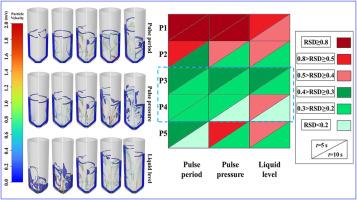Hydrodynamics study of solid−liquid mixing in a novel pulsed precipitation reactor based on DEM–VOF simulation
IF 4.3
2区 材料科学
Q2 ENGINEERING, CHEMICAL
引用次数: 0
Abstract
Efficient and reliable precipitation reactors are of great significance for the recovery of spent nuclear fuel. However, most current spent nuclear fuel precipitation reactors rely on agitation-driven mixing, which suffers from low mixing efficiency and high failure rates. In this study, a pulse pressure-driven spent nuclear fuel precipitation reactor was designed and its hydrodynamics performance were investigated using a CFD–DEM–VOF coupled numerical approach. Three key process parameters were systematically examined, including pulse period, pulse pressure, and initial liquid level. The simulation results revealed that pulse period and pulse pressure significantly influenced hydrodynamic behavior and particle suspension performance, whereas the initial liquid level had a subordinate effect. Under optimized pulse conditions, effective mixing and uniform particle suspension could be achieved regardless of the initial liquid height. Furthermore, a quantitative evaluation of mixing and suspension performance was conducted based on average flow velocity, average turbulent kinetic energy, and the relative standard deviation of particle suspension uniformity. The results demonstrated that efficient fluid mixing and homogeneous particle suspension could be realized under appropriate operating conditions. This study provides theoretical guidance for developing high-performance pulse-driven precipitation reactors and optimizing their operational processes in spent nuclear fuel treatment.

基于DEM-VOF模拟的新型脉冲沉淀反应器固液混合流体动力学研究
高效可靠的沉淀堆对于乏燃料的回收具有重要意义。然而,目前大多数乏燃料沉淀堆采用搅拌驱动混合,存在混合效率低、故障率高的问题。设计了脉冲压力驱动的乏燃料沉淀堆,采用CFD-DEM-VOF耦合数值方法研究了乏燃料沉淀堆的流体力学性能。系统地检查了三个关键工艺参数,包括脉冲周期、脉冲压力和初始液位。仿真结果表明,脉冲周期和脉冲压力对流体动力行为和颗粒悬浮性能有显著影响,初始液位的影响较小。在优化的脉冲条件下,无论初始液体高度如何,均能实现有效的混合和均匀的颗粒悬浮。基于平均流速、平均湍流动能和颗粒悬浮均匀性的相对标准偏差,对混合和悬浮性能进行了定量评价。结果表明,在适当的操作条件下,可以实现高效的流体混合和均匀的颗粒悬浮。该研究为开发高性能脉冲驱动沉淀堆及优化其乏燃料处理操作流程提供了理论指导。
本文章由计算机程序翻译,如有差异,请以英文原文为准。
求助全文
约1分钟内获得全文
求助全文
来源期刊

Particuology
工程技术-材料科学:综合
CiteScore
6.70
自引率
2.90%
发文量
1730
审稿时长
32 days
期刊介绍:
The word ‘particuology’ was coined to parallel the discipline for the science and technology of particles.
Particuology is an interdisciplinary journal that publishes frontier research articles and critical reviews on the discovery, formulation and engineering of particulate materials, processes and systems. It especially welcomes contributions utilising advanced theoretical, modelling and measurement methods to enable the discovery and creation of new particulate materials, and the manufacturing of functional particulate-based products, such as sensors.
Papers are handled by Thematic Editors who oversee contributions from specific subject fields. These fields are classified into: Particle Synthesis and Modification; Particle Characterization and Measurement; Granular Systems and Bulk Solids Technology; Fluidization and Particle-Fluid Systems; Aerosols; and Applications of Particle Technology.
Key topics concerning the creation and processing of particulates include:
-Modelling and simulation of particle formation, collective behaviour of particles and systems for particle production over a broad spectrum of length scales
-Mining of experimental data for particle synthesis and surface properties to facilitate the creation of new materials and processes
-Particle design and preparation including controlled response and sensing functionalities in formation, delivery systems and biological systems, etc.
-Experimental and computational methods for visualization and analysis of particulate system.
These topics are broadly relevant to the production of materials, pharmaceuticals and food, and to the conversion of energy resources to fuels and protection of the environment.
 求助内容:
求助内容: 应助结果提醒方式:
应助结果提醒方式:


